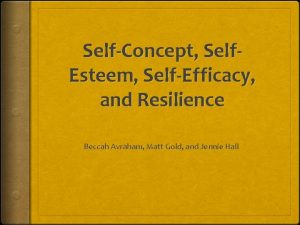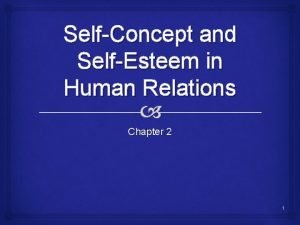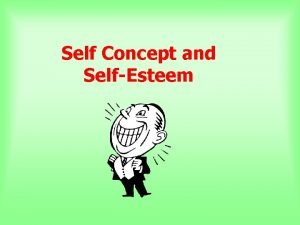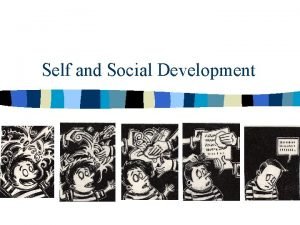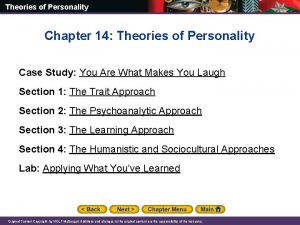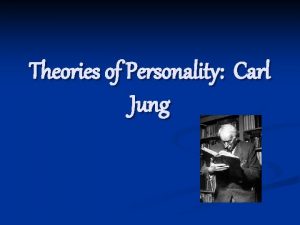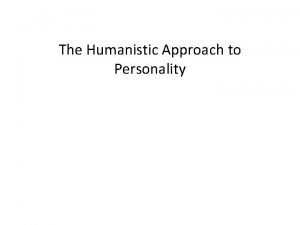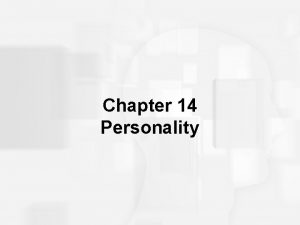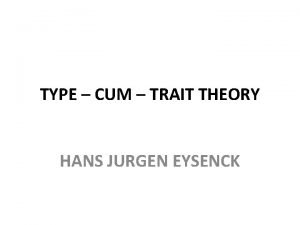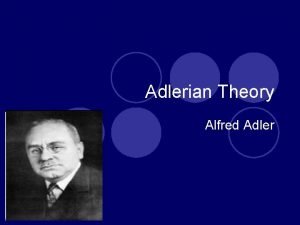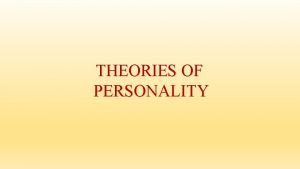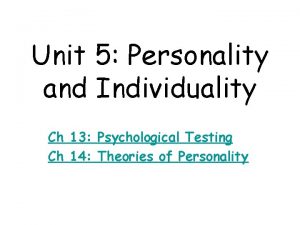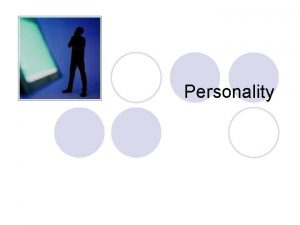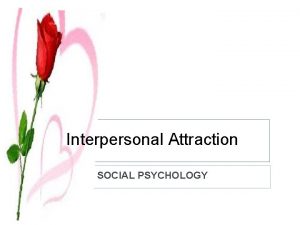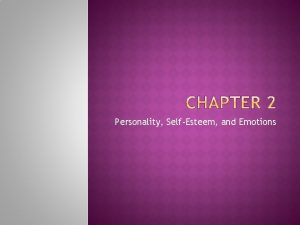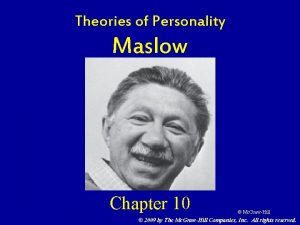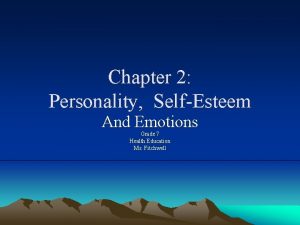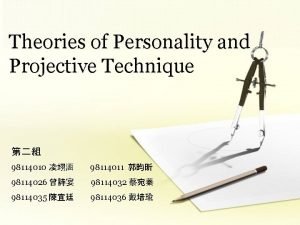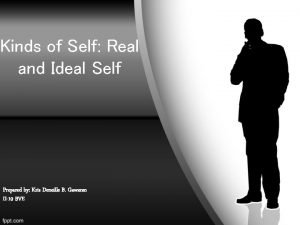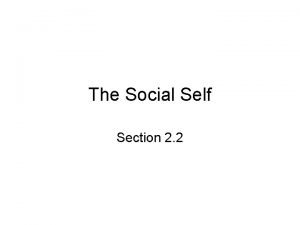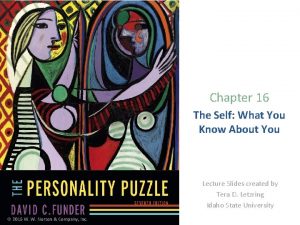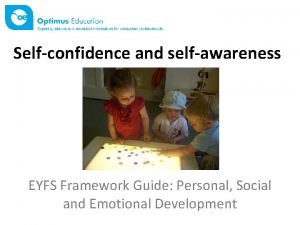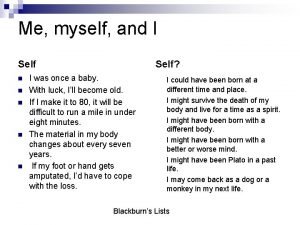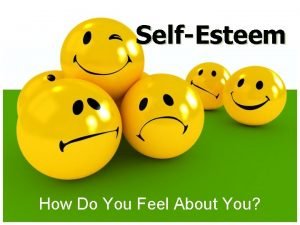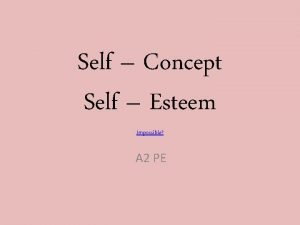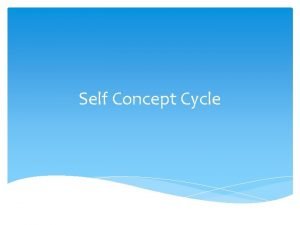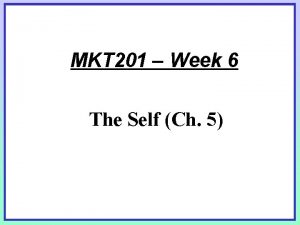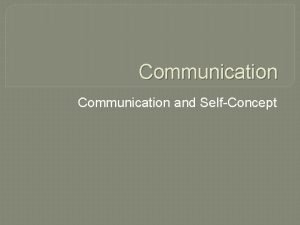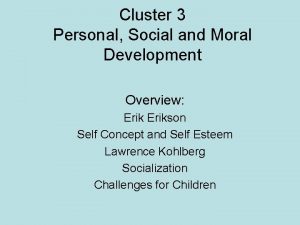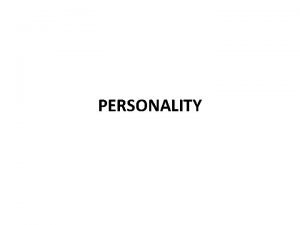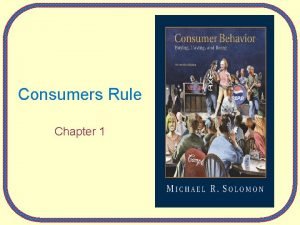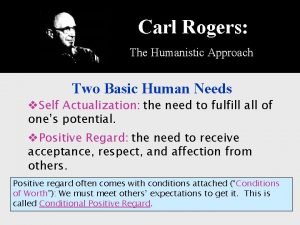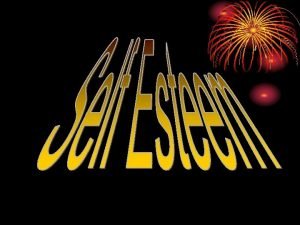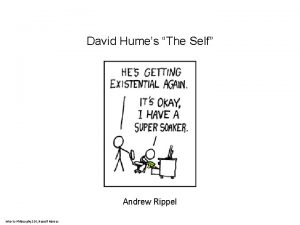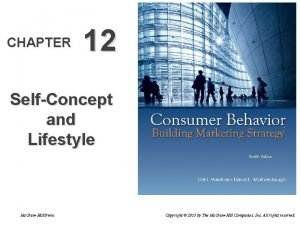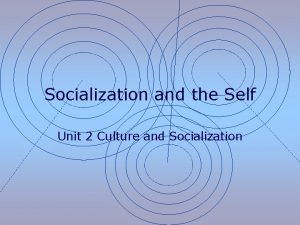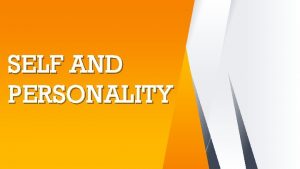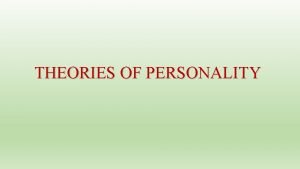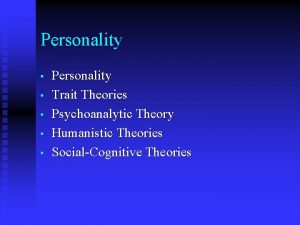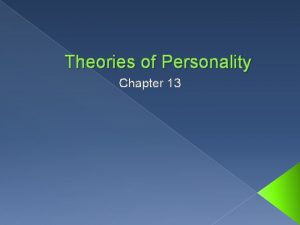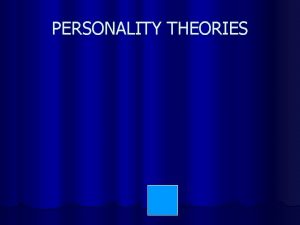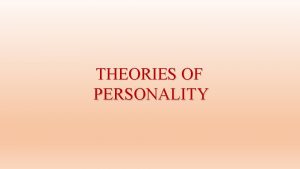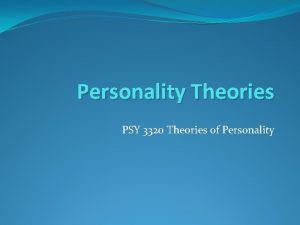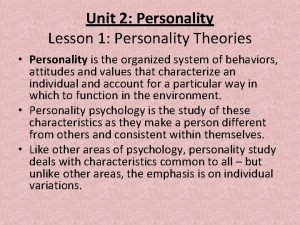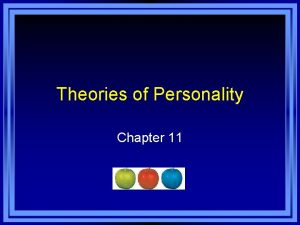PERSONALITY SELF CONCEPT Theories of Personality Self concept












































- Slides: 44

PERSONALITY & SELF CONCEPT Theories of Personality & Self concept and how they affect one’s consumption patterns

Personality Some theorists prefer to view personality as a unified whole. Others focus on specific traits. Definition Sum total of outer physiological and inner psychological characteristics that both determine and reflects how a person responds to his or her environment”.

Nature Of Personality reflects individual differences Unique combination of inner characteristics No two individuals are exactly alike Venturesome (scuba diving, rock climbing) to some others who are not venturesome. Personality allows marketers to divide people into different groups based on their traits.

Nature Of Personality is Consistent & Enduring Mother – “child has been impulsive from the day he was born” – enduring & consistent. Marketers cannot change consumers personalities to meet their products. But understanding which specific characteristics is required to bring responses, can help marketers to appeal to these traits in their target audience.

Nature Of Personality Can Change May be altered by major life events – birth of a child, death of a loved one, personal tragedies – accident, health problem, divorce, significant career promotion. Personality changes can also be part of maturing process. Women’s personality in general has been changing faster. (Indica V 2 Ad)

Theories of Personality Freudian Theory Neo – Freudian Theory Trait Theory

Freudian Theory Personality consists of three interacting systems. Id – related to physiological or impulsive needs to which one seeks immediate satisfaction. Super Ego – individuals internal expression of moral / ethical codes of conduct; socio–cultural forces. Ego – The individuals conscious control. Functions as an internal monitor that attempts to balance the impulsive needs and socio cultural constraints.

Freudian Theory Built on the premise that unconscious needs or drives, especially biological drives are at the heart of human motivation – ulterior motives. Gratification Ego System 3 Id System 1 Super Ego System 2

ID EGO SUPER EGO The Quest Primal desires Basic Nature Reason and Self-Control for Perfection

I want a chocolate Eat a small bar of Chocolate You’re on a diet

Figure 5. 1 Ad Portraying the Forces of the Id

Freudian Theory and “Product Personality” Consumer researchers using Freud’s personality theory see consumer purchases as a reflection and extension of the consumer’s own personality

Table 5. 1 Snack Food Personality Traits Potato Chips: Ambitious, successful, high achiever, impatient (annoyed) Tortilla Chips: Perfectionist, high expectations, punctual, conservational Pretzels: Lively, easily bored, flirtatious, intuitive Snack Crackers: Rational, logical, contemplative, shy, prefers time alone

Although Ego is capable of resolving many of the conflicts arise between the personality components, ------- there are certain occasions when no solutions could be achieved, leading to tensions within Defense mechanisms are unconsciously determined techniques for avoiding or escaping from such high levels of tension.

Defense Mechanisms Repression: resolving conflict by minimizing aspects of the conflicting situation. (conflict about watching sporting event which brings in violent and entertaining aspects. As ego cannot reach the compromise, the individual will work to reduce the violent aspects of the sport in his mind). Projection: feelings generated by individual’s id or super ego is ascribed to another person or group; (a persons disdain for others who constantly purchase products and display them can be from their own desire to engage in same behavior).

Identification: the individual unconsciously imitates the behavior of another person who has successfully handled a similar conflict. Vijay Mallya appearing in ads which says, “I enjoy my drink, but I never drive after I drink”. Reaction Formation: unconscious feelings held toward others are consciously expressed as opposites. … a partner who is un-loyal might actually purchase many gifts for the other person.

Neo Freudian Personality Theory Social relationships are fundamental to formation of personality (Freud - impulsive in nature) Three personality Groups HORNEY’S CAD theory 1. Compliant Individuals – those who move towards others (desire to be loved, wanted and appreciated). 2. Aggressive Individuals – those who dominate and even excel (desire to excel / win admiration). 3. Detached Individuals- those who move away from others- indifferent (desire independence, self reliance, self sufficiency - freedom from obligation)

Figure 5. 3 Ad Applying Horney’s Detached Personality

Trait Theory Departure from qualitative measures that typify the earlier theories. Quantitative or empirical in approach. Measurement of personality in terms of specific psychological characteristics called ‘traits’. Checks personality traits related to how consumer makes his choices ----

The trait theory is based on three assumptions. 1. Individuals possess relatively stable behavioral tendencies. 2. Different people differ in the degree to which they possess these tendencies. 3. When identified and measured, these relative differences between individuals are useful in characterizing their personalities.

Personality Traits 1. Consumer Innovativeness: Nature and boundaries of a consumers willingness to innovate 2. Dogmatism: Trait that measures the degree of rigidity (vs. openness) that they show toward an information that is contrary to their own established beliefs. 3. Social Character: Ranges from inner-directedness to other directedness. Inner directed consumers tend to rely on their own inner values while evaluating new products. While outer-directed tend to look for other’s opinion.

Dogmatism Consumers low in dogmatism (open-minded) are more likely to prefer innovative products to established or traditional alternatives Highly dogmatic consumers tend to be more receptive to ads for new products or services that contain an appeal from an authoritative figure

Figure 5. 4 Ad Encouraging New Product Acceptance

Personality Traits (contd. ) 4. Need for uniqueness: for such people, conformity to others expectations or standards either in appearance or in their possessions is something to be avoided. 5. Optimum Stimulation Level: Some people prefer a simple, uncluttered and calm existence (whereas others prefer complex and unusual experiences). High OSL is linked to greater willingness to risks, try new products …. 6. Sensation Seeking: characterized by the need for varied, novel and complex experiences and willingness to take physical and social risks.

Consumer attributes • People buy product that are compatible with their SELF-CONCEPT • Or rather that enhance their “ideal-self|”

The self-concept • The self consists of the body, family, possessions, moods, emotions, conscience, attitudes, values, traits, and social position • The self-concept plays a central role in behavior and psychological processes. • Major distinction between independent self and interdependent self; ‘me’ as a unique entity or ‘me’ as integrated in the social environment.

The self-concept • The concept of self is rooted in individualism • A person is an autonomous entity • In the collectivist model of the self, persons are fundamentally interdependent with one another • A person is an interdependent entity

Self Concept Is defined as the totality of individuals thoughts and feelings having reference to him/ her as an object. Life style, in many ways, is an outward expression of ones self-concept.

Self Concept - Theory Holds that an individuals have a concept of self based on who they think they are (the actual self) ………… and a concept of who they think they would like to be (the ideal self). Related to two key concepts of psycho-analytic theory, the ego and the super ego. Ego is similar to one’s objective reality, so its similar to actual self. Superego is defined by the way things should be and hence can be seen as a reflection of ideal self.

Actual Self There is no one actual self. Consumers have various role identities – mother, wife, working woman, volunteer etc. One of these roles is dominant in specific situations. This particular role affects the behavior (dressing style, talking, way they conduct etc) The amalgam of individuals roles makes up the individual self.

Studies have confirmed that consumers buy products related to their self concept. Dolich – studied buying of beer, cigarettes, soaps and tooth paste and found that respondents tend to prefer brands they rate similar to themselves. The same is in the case of automobiles too. Marketing takeaways: the concept of ‘actual self’, says that image consumers have of themselves influences their purchases. They attain ‘self consistency’, by buying products they perceive as similar to their self-concept

Relationship Between Self Concept & Brand Image Influence Product (Brand Image) Relationship Between self concept & brand image Behavior Seek products and Brands that improve/ maintain self concept. Consumer (self concept) Reinforces Self-Concept Satisfaction Purchases Contribute to Desired self concept

Ideal Self Concept of ideal self relates to ones self esteem. The greater the difference between the actual self and the ideal self, the lower an individuals self esteem. Dissatisfaction with actual self, will end up in purchases of such products that they think will enhance their ‘self-esteem’. A woman who would like to be more modern, efficient and imaginative will use different perfumes, deodorant or shop at different stores than a woman who want to be warm/attractive.




(Marsh L Richins) – advertising themes and images often increase the discrepancy between the real and ideal selves. Ads that features beautiful models and luxurious life styles leaves a sense of inadequacy based on a comparison of their real self with idealized self. Average fashion model is 5’ 9’’ tall and weighs 55 kgs. But the average Indian Woman is 5’ 2’’ tall and weighs 65 kgs.

The desire for both self consistency and self esteem can be conflicting. Generally consumers buy products that conform to their actual self image. But if they are lower in their self esteem they are more likely to be swayed by appeals to fantasy that portray an idealized self …. the alluring woman, the lone biker on Bajaj Discover or well groomed male in Vimal suiting. Buying to achieve an unrealizable self image can lead to compulsive purchasing behavior (frequent buying to overcome the discrepancy between the real and the ideal self).

Dimensions Of Self Concept Actual Self Concept Private Self Social Self Ideal Self Concept Actual Self How I actually see myself Ideal self How I would like to see myself Social Self How others actually see me Ideal Social Self How I would like others to see me.

In different contexts, consumer’s behavior might be guided by different self concepts. Daily use items including consumer durables purchase will be more guided by actual self concept. Socially conspicuous products or status products will be guided by social self image. Fantasy products cosmetics, fashion items or accessories will be guided by ideal self image or ideal social self image.

Extended Self Not only does our self image influence the products we choose, but the products (of symbolic value) we possess frequently influence our self image. Extended self incorporates some of our more important possessions into our self concept. We are what we wear, and what we use. “People seek, express, confirm and ascertain a sense of being through what they have”.

The symbolic role that products play in shaping the consumer’s self concept. Marketers have understood the role of product constellations in projecting an image. Advertising for jewelry might show fashionably dressed models or expensive automobiles …. . And ads for clothing might show jewelry. This brings in opportunity for co-branding

Lifestyles & Psychographics Life style, in many ways, is an outward expression of ones self-concept. Life style it can be viewed as a unique pattern of living which influences and reflected by one’s buying habits. Psychographics may be viewed as the method of defining lifestyle in measurable terms.

The Nature Of Lifestyles Lifestyle variables are defined by how people spend their time (activities), what they consider important in their environment (interests), and what they think of themselves and the world around them (opinions). Activities: - Work, Hobbies, Social Events, Vacation, Entertainment, Club Membership Interests: - Family, Home, Job, Community, recreation, Fashion Opinions: - Personal Relations, Social issues, politics, Business, Economics, Education
 The ideal self meaning
The ideal self meaning Self image vs self perception
Self image vs self perception All thoughts
All thoughts Self concept vs self esteem
Self concept vs self esteem Self image vs self perception
Self image vs self perception What does the psychoanalytic approach to personality teach
What does the psychoanalytic approach to personality teach Psychic inheritance jung
Psychic inheritance jung Personality quiz
Personality quiz Theories of personality quiz
Theories of personality quiz Dogmatism in consumer behaviour
Dogmatism in consumer behaviour Eysenck trait theory
Eysenck trait theory What is adler's theory of personality
What is adler's theory of personality Allport personality theory
Allport personality theory Raymond cattell was a psychologist who ________.
Raymond cattell was a psychologist who ________. Theories of personality
Theories of personality Theories of interpersonal attraction in social psychology
Theories of interpersonal attraction in social psychology Personality self esteem and emotions
Personality self esteem and emotions Silhouette self portrait
Silhouette self portrait Self actualized person characteristics
Self actualized person characteristics Chapter 2 personality self-esteem and emotions
Chapter 2 personality self-esteem and emotions Children's apperception test cards ppt
Children's apperception test cards ppt An idealized image that we have developed over time
An idealized image that we have developed over time I self and me self difference
I self and me self difference Contoh ideal self dan real self
Contoh ideal self dan real self Declarative self vs procedural self
Declarative self vs procedural self Eyfs
Eyfs Me myself and i self concept
Me myself and i self concept Self concept definition
Self concept definition Self-concept beliefs
Self-concept beliefs Types of self-concept
Types of self-concept Self-concept examples
Self-concept examples Reflected appraisal
Reflected appraisal Self esteem erikson
Self esteem erikson Self concept definition
Self concept definition Carl rogers personality theory
Carl rogers personality theory Rogers concept of self
Rogers concept of self Self concept attachment
Self concept attachment Do marketers promise miracles
Do marketers promise miracles Carl rogers self actualization
Carl rogers self actualization Self concept and interpersonal communication
Self concept and interpersonal communication Self concept circle
Self concept circle The bundle
The bundle Kinch's model
Kinch's model Self concept and lifestyle
Self concept and lifestyle Mead concept of self
Mead concept of self

